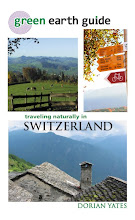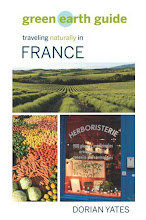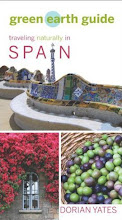
A word about my cooking style. As you can see from my recipes I am an "approximate" cook, not a meticulous baker. In our home, my husband, a fine carpenter and house builder, is the baker, extending his precision to eclairs, cakes and other recipes requiring exacting measurements. I, on the other hand, fall into the "a pinch here, a handful there" category, able to improvise with what I have pretty easily. For creations I particularly like I make mental notes of quantities and special ingredients. Here is a pizza favorite, easily changed and adapted for personal preferences in terms of cheeses and toppings, made with some local Spanish delicacies.
Sheep Cheese and Pesto Gluten-Free Pizza with fresh Peppers, Sun-dried Tomatoes and Olives
Ingredients per pizza
Gluten-Free Crust - 1 8-10" crust
Olive Oil (over 40 organic olives oils in Spain to choose from) - 1 Tablespoon
Pesto - 1-2 Tablespoons
Green and Red Peppers - 1/4 each
Olives - handful
Sun-dried Tomatoes - 1-2 slices chopped
Bake the crust with nothing on it for a couple of minutes. Then rub a little olive oil on the crust - not much- about 1 tablespoons - rubbing it to all parts of the crust with your fingers.
Next spread a similar amount of pesto (see below) on the crust. If you are traveling without access to a food processor or great chopping facilities, I would opt for pre-made pesto sold at the markets or in jars in stores.
Slice thinly or grate the cheese. Sheep (
Oveja) cheese is quite prevalent in Spain. If you are using it for taste - any will do. If you have allergies to cow milk, then make sure you read the label or ask at the market counter to make sure it is
queso puro de oveja sin leche de vaca (pure sheep cheese without cow milk).
My favorite cheese for this pizza is made from smooth raw sheep milk,
Queso Extramuros, crafted by artisans in the Natural Park of Sierra de Espadán, in Castellon north of Valencia.
Los Corrales makes a variety of cheeses from goat and sheep milk, curing the rind with olive oil so it is edible.You can find this special cheese at the organic food stall,
La Morhada, at Valencia's Mercado Central. This cheese melts very quickly so the trick is to watch the pizza as it will easily get overcooked - just a few minutes in the oven. Once it is gently melted, remove the pizza from the oven. Add chopped green (and red) peppers, organic olives and some chopped sundried tomatoes.
Serve with a mixed green salad and
Limonada con Menta. All I can say is "yum!"
The Crust:
In Spain gluten-free (
sin-gluten) products are fairly abundant and easy to find in large supermarkets and health food stores as well as small
herboristerias. The easiest to use are the pre-made crusts, but if you are feeling creative you can make a crust from scratch - all you need is the flour mix, water and oil ( I do not use yeast in mine). If you are traveling it is simplest really to buy the pre-made crust, or next to that buy a gluten-free flour mix - otherwise you end up with multiple bags of different kinds of flours (rice, tapioca, potato starch, or others depending upon your personal preferences). The pre-made crusts are small, one-two person portion size. Depending where you find yourself in Spain brand names of Gluten-Free pre-made Crusts will include Proceli, Schar, Sense Gluten, and Artediet.
Homemade Pesto (if you have access to a food processor or great chopping and mixing facilities):
Basil (
albahaca in Spanish)- A pile of fresh basil leaves - closer to a small mountain as far as I am concerned. Basil ranks up there with olive oil in my book - the more the better.
Nuts/Sunflower Seeds - Pine Nuts (
piñones)are traditional. I use those or sunflower seeds (
semillas de girasol) due to allergies to other nuts, but you can certainly use walnuts (
nueces) or almonds (
almendras) if you like. About 1/2 cup for every 2-3 large handfuls of basil.
Lemon Juice - just 1- 2 tablespoons
Garlic (
ajo)- 1-3 cloves - personal preference
Olive Oil (
aceite de oliva) - to make a pasty to runny consistency
Cheese (
queso)- Parmesan is traditional, but you can use whatever you like...I tend to not add the cheese if I am using it on pizzas or other dishes that will contain cheese
Put the nuts/seeds in a food processor and grind, then add the garlic, lemon juice, and as much basil as will fit in the bowl with about 1/4 cup of olive oil. Blend and then keep adding olive oil while the food processor is on until the desired consistency is reached. If you are adding cheese, do that last.
1 Day until
Earth Day - celebrate for a lifetime!

 Travelers from the United States may be quite surprised when they are shopping at markets and in stores in Europe to find that eggs are often not refrigerated. In fact they are often not even in cartons, but available for the picking into your own container.
Travelers from the United States may be quite surprised when they are shopping at markets and in stores in Europe to find that eggs are often not refrigerated. In fact they are often not even in cartons, but available for the picking into your own container.























